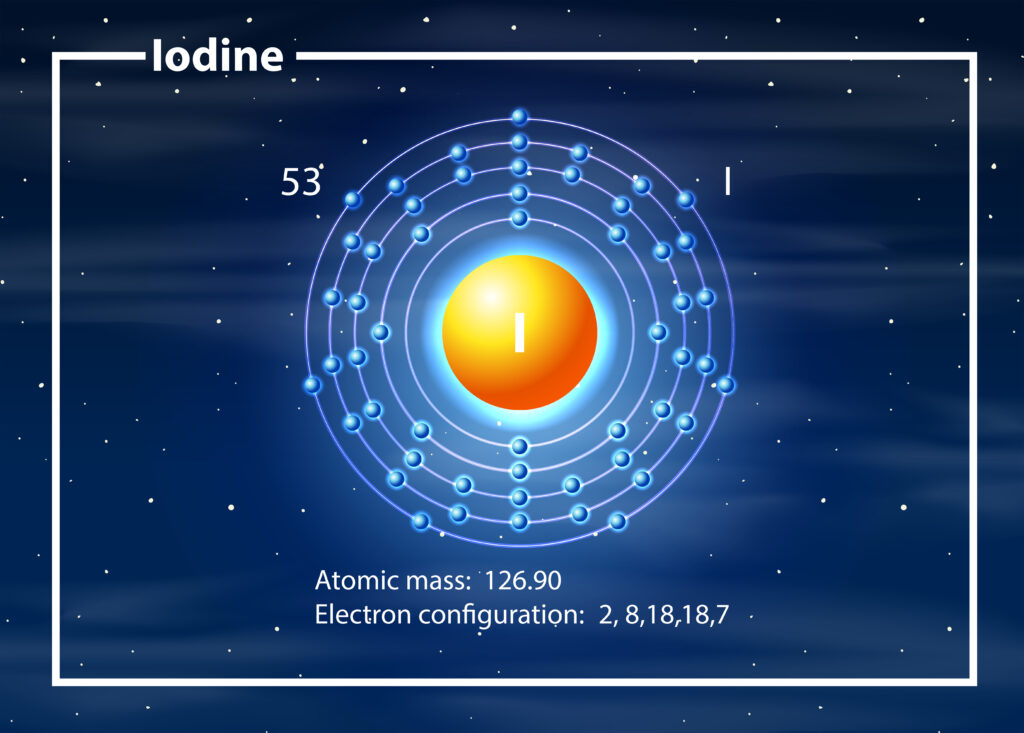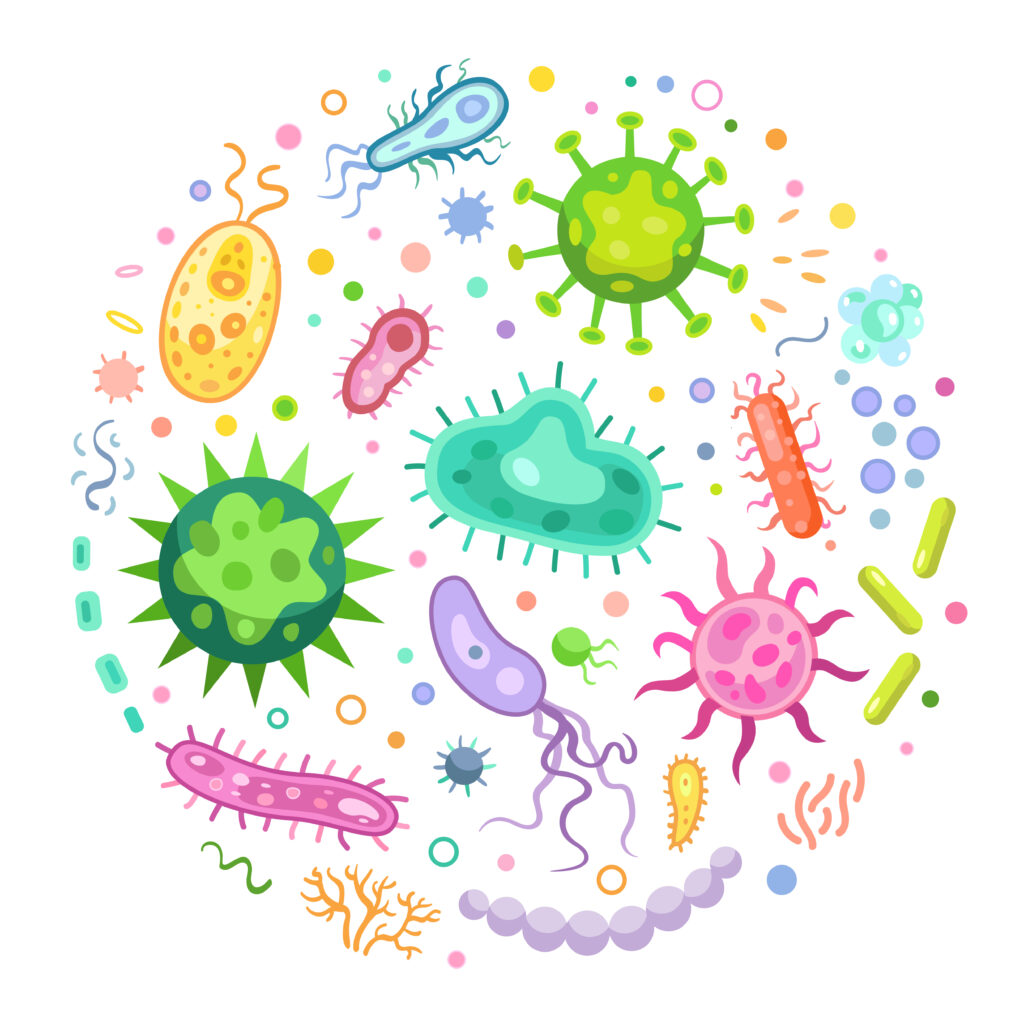Iodine – properties, action and occurrence of iodine

Iodine is a micro-element necessary for the proper functioning of the nervous system and the thyroid gland and all processes regulated by it. Disorders of iodine absorption are associated not only with hypothyroidism and hyperactivity of this gland. They also have a negative impact on the reproduction and mental development of children and adolescents. Find out what to eat to ensure a sufficient dose of iodine and is it worth taking supplements containing this element?
Source ![]() https://www.duolife.ie/iodine-properties/
https://www.duolife.ie/iodine-properties/
Iodine is trace but important
The concentration of iodine in human organs is low, because it reaches about 20-25 mg. Iodine (I) is also classified as a microelement, substances found in humans in trace amounts. Most of this element accumulates in the thyroid gland, which captures it from the body. It is with this small but very important gland that the most important role of iodine is associated. Its amount depends on the secretion of triiodothyronine (T3) and thyroxine (T4), two thyroid hormones responsible for a number of important processes. What features are we talking about? T3 and T4 regulate cellular metabolism, making it possible to maintain a healthy weight. In other words, they are responsible for the efficient conversion of nutrients into energy. They control body temperature, and also affect the functioning of the nervous and circulatory systems and muscle work. They condition the growth and development of body cells.
Iodine deficiency is harmful
When there is not enough iodine in the diet, there are problems with the nervous system – difficulties with concentration and memory, as well as learning. If pregnant women do not get enough of it, they risk fetal brain underdevelopment. Lack of iodine in adolescence makes children grow slower and assimilates less knowledge.
The thyroid gland has to work harder to absorb iodine from the body, which is enabled by the TSH hormone produced by the pituitary gland. This increased work of the thyroid gland, especially when iodine deficiency is permanent, results in the formation of a goiter in the neck, and consequently leads to thyroid disorders, especially hypothyroidism, and even cancer.
If we want to avoid this, we should eat adequate amounts of food containing iodine. The daily requirement for this micronutrient is 150 mcg (micrograms) for an adult and adolescents. In pregnant women, this amount increases significantly and ranges from 200-300 mcg.
Iodine deficiency and thyroid diseases
Of course, disturbances in the functioning of the thyroid gland may depend on several factors. Its hyperfunction consists in producing too much of these hormones in relation to the body’s needs. The reasons for this may be, for example, Garves Basedow’s disease (an autoimmune disease genetically determined) or a history of thyroiditis. However, the reason may be the deficiency of iodine, which leads to the formation of goitre and nodules in the area of the thyroid gland.
This gland is overactive more often than underactive. It also affects women more often than men. It is manifested by a sharp weight loss despite the persistent appetite, increased sweating, dryness and roughness of the skin, hyperactivity, cardiac arrhythmia, hair loss or eye problems.
The symptoms of hypothyroidism are the opposite. First of all, the metabolism slows down, so we gain a few kilos, despite the fact that we have not changed our eating habits. We are also bothered by a general slowdown – we become lethargic and tired, we have no energy to live. We feel a drop in body temperature and even on warmer days we feel cold, especially after getting out of bed, and our hands and feet are also cold. Other symptoms include: deteriorating skin condition – appearance of acne, dandruff, peeling of the epidermis; hair loss, weak nails, bags and dark circles under the eyes, difficult to concentrate and remember, nervousness, decreased immunity or deregulation of the menstrual cycle.
Sources of iodine
Iodine deficiencies and associated thyroid disease have become so common that iodine enrichment in table salt has been ordered. Salt is by no means the only source of this element in food, and certainly not the healthiest one. Therefore, it is worth reaching for sea fish (salmon, mackerel, herring, cod, pollock are especially rich in this ingredient), seafood, milk, some grain products and vegetables (at least those from iodine-rich land). In addition, iodine enters our body through the skin and respiratory tract. Hence, it is advisable that people with a thyroid gland regularly go to the seaside and sunbathe a little more often – they usually suffer from vitamin D deficiency.
There is also the fact that other elements affect the reduction of iodine bioavailability. These are fluorine, bromine and chlorine, the large amount of which in the body displaces iodine. All the more so, we should enrich the diet with the previously mentioned nutritional products. On the other hand, selenium and magnesium, elements that contain nuts and seeds in large amounts, increase the absorption of iodine.
Overdose is also dangerous
If we have a well-balanced diet with an abundance of iodine, it is not necessary to take dietary supplements. This can lead to the appearance of an excess of this element in the body, and as we already know, it increases the risk of developing hyperthyroidism. By the way, other symptoms of iodine overdose are drooling, a metallic taste in the mouth, stomach ailments and skin lesions.
Iodine radiation therapy
One of the treatments for an overactive thyroid is radioiodine therapy. It is used when other methods have failed or, for some reasons, are less beneficial to the patient’s body. This method of treatment is uncomplicated – it consists in taking orally the appropriate preparation. Usually, however, it can be burdensome for the patient and his relatives, as it requires limited contact, especially with children and pregnant women. During therapy, sexual activity is also discouraged, but increased attention to hygiene and cleanliness is recommended. This type of treatment is excluded from pregnancy. You cannot get pregnant until six months after its termination.







Responses